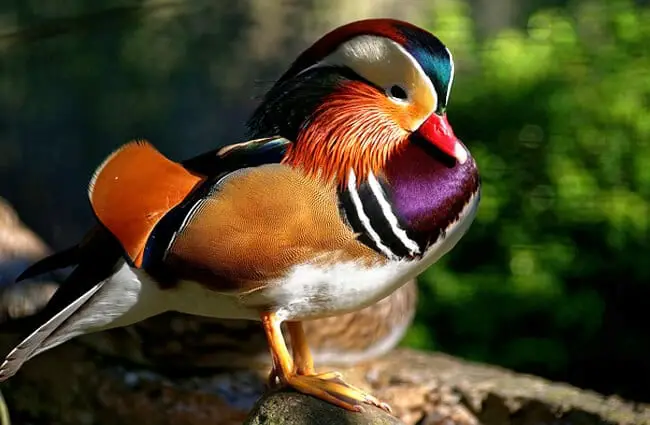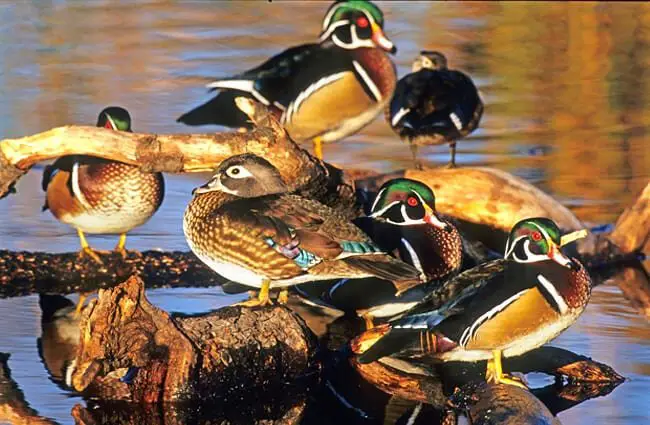A Jewel of the Wetlands: Exploring the World of the Wood Duck
The Wood Duck, Aix sponsa, is arguably North America’s most stunning waterfowl. Often called the “ghost duck” due to its elusive nature and preference for shadowy forested wetlands, this bird is a captivating blend of iridescence and grace. More than just a beautiful face, the Wood Duck plays a vital role in its ecosystem and boasts a fascinating evolutionary history. This article dives deep into the life of this remarkable species, covering everything from its habitat and diet to its unique breeding behavior and conservation status.

Habitat and Distribution
Wood Ducks are primarily found in wooded swamps, marshes, and ponds across eastern North America, from southeastern United States through Canada and into the northern United States. They require mature forests near water sources, with trees suitable for nesting cavities. These cavities are not created by the ducks themselves; they rely on natural holes formed by decay, woodpeckers, or other animals. A healthy forested wetland is crucial to their survival. They also utilize beaver ponds extensively, as beaver activity creates ideal nesting and foraging opportunities. During winter, Wood Ducks migrate south to warmer climates, often found in coastal marshes and estuaries.
Evolutionary History
The Wood Duck lineage is surprisingly complex. While clearly belonging to the dabbling duck family, genetic evidence indicates that the wood duck shares its closest relatives with species native to Asia. Fossil evidence suggests that wood duck ancestors existed millions of years ago. The species experienced a severe decline in the late 19th and early 20th centuries due to habitat loss and overhunting. This decline, however, spurred one of the earliest and most successful conservation efforts in North America. Regulations were put in place, and dedicated nest box programs were established, ultimately bringing the Wood Duck back from the brink of extinction. This is a testament to the effectiveness of focused conservation initiatives.
Diet and Foraging Behavior
Wood Ducks are omnivorous, with their diet varying seasonally and depending on availability. During breeding season, they primarily consume aquatic insects, snails, and vegetation. They forage by dabbling, tipping forward in the water to reach submerged plants and invertebrates. In the fall and winter, their diet shifts towards seeds, nuts, and grains, often found in flooded fields or along shorelines. They are also known to consume fruits and berries when available. Wood Ducks are adept at gleaning food from both the water surface and the substrate, showcasing their versatility as foragers.

Mating and Reproduction
The Wood Duck is renowned for its elaborate courtship displays. Male Wood Ducks are strikingly colorful, boasting iridescent plumage, a crested head, and distinctive markings. During breeding season, males engage in complex aerial acrobatics and vocalizations to attract females. Pair bonds are typically formed relatively quickly.
Nesting is a unique aspect of Wood Duck reproduction. Unlike most ducks, Wood Ducks are cavity nesters, meaning they build their nests inside tree holes. The female will select a suitable cavity, often located high above the ground, and line it with down feathers and vegetation. She will lay a clutch of 7 to 15 eggs, incubating them for approximately 28 to 30 days.
Ducklings are precocial, meaning they are relatively independent shortly after hatching. They will leave the nest cavity within a day or two, guided by their mother to nearby feeding grounds. Ducklings are capable of flying at around 35 to 40 days old, and they will soon disperse to establish their own territories.

Ecological Role and Interactions
Wood Ducks play an important role in their ecosystem. As consumers of aquatic insects and seeds, they help regulate populations and disperse plant life. They also serve as prey for various predators, including foxes, raccoons, hawks, and owls. Their nesting habits create cavities that are subsequently used by other cavity-nesting birds and mammals, furthering biodiversity.
Wood Ducks often coexist with other waterfowl species, such as Mallards and Black Ducks. Competition for resources can occur, but Wood Ducks preference for forested wetlands often minimizes direct competition. They also exhibit interesting behaviors, such as “rafting,” where multiple birds gather on the water surface for protection and socialization.
Wood Duck and Human Interaction
Historically, Wood Ducks were heavily hunted for their feathers and meat, which led to their near extinction. Fortunately, conservation efforts and hunting regulations have helped to restore their populations. Today, Wood Ducks are a popular game bird, but sustainable hunting practices are crucial to ensure their long term survival.
Nest box programs continue to be an effective way to support Wood Duck populations, particularly in areas where natural nesting cavities are limited. Many individuals and organizations actively participate in building and maintaining these nest boxes, providing valuable habitat for this beautiful species.

Wood Duck in Culture
The striking appearance of the Wood Duck has inspired artists and writers for generations. Its image appears on various forms of art, from paintings and sculptures to photographs and illustrations. Native American cultures often regarded the Wood Duck as a symbol of beauty, grace, and renewal. It is sometimes featured in folklore and traditional stories.
Finding Wood Ducks in the Wild
If you’re hoping to spot a Wood Duck, focus your efforts on forested wetlands, swamps, and ponds. Look for areas with standing timber and abundant vegetation. Early morning and late evening are often the best times to observe them, as they are most active during these hours. Bring binoculars for a closer view, and be patient—Wood Ducks can be elusive. Remember to observe them from a respectful distance and avoid disturbing their habitat.
For Zookeepers and Aviculturists
Caring for Wood Ducks in captivity requires attention to their specific needs. Provide a spacious enclosure with both land and water areas, mimicking their natural habitat. Ensure the water is clean and well filtered. Their diet should consist of a balanced waterfowl feed supplemented with insects, vegetation, and seeds.
Wood Ducks are prone to certain health issues, such as aspergillosis, a fungal infection. Regular veterinary checkups and preventative care are essential. Provide opportunities for natural behaviors, such as foraging and nesting. Avoid overcrowding, as this can lead to stress and aggression. Encourage pair bonding by providing suitable nesting materials.

Fascinating Facts About Wood Ducks
- Wood Duck eggs are laid directly into the nest cavity, sometimes as many as 15 eggs!
- Ducklings will jump from the nest cavity, often from considerable heights, relying on their downy feathers to cushion their fall.
- Male Wood Ducks undergo a complete molt after breeding season, losing their vibrant plumage and taking on a more subdued appearance.
- Wood Ducks are remarkably adept at flying through dense forests, navigating with surprising agility.
- They are known to create “dust baths” by flapping their wings in dry dirt or sand, helping to keep their feathers clean and free of parasites.

The Wood Duck stands as a testament to the power of conservation and the enduring beauty of the natural world. From its striking plumage to its unique nesting habits, this remarkable bird continues to captivate and inspire. By understanding its ecology and behavior, we can ensure that this jewel of the wetlands continues to thrive for generations to come.

![Red Angus Closeup of a beautiful Red Angus cowPhoto by: U.S. Department of Agriculture [pubic domain]https://creativecommons.org/licenses/by/2.0/](https://animals.net/wp-content/uploads/2020/03/Red-Angus-4-238x178.jpg)




![Red Angus Closeup of a beautiful Red Angus cowPhoto by: U.S. Department of Agriculture [pubic domain]https://creativecommons.org/licenses/by/2.0/](https://animals.net/wp-content/uploads/2020/03/Red-Angus-4-100x75.jpg)

